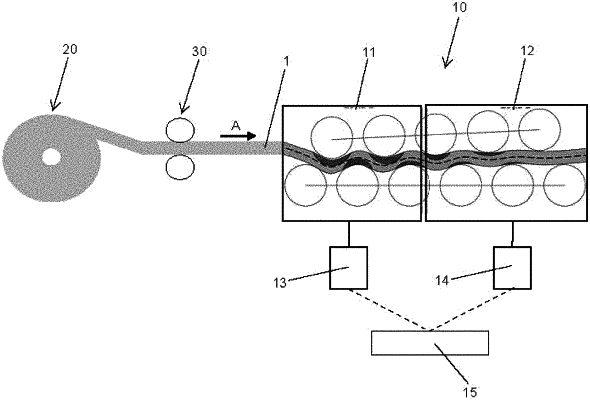| CPC B21D 1/02 (2013.01) [B21B 38/00 (2013.01)] | 14 Claims |

|
1. A method of controlling a leveling machine that is configured to level a sheet material, the leveling machine including a first group of work rolls and a second group of work rolls, the second group of work rolls being located forward of the first group of work rolls in relation to a forward movement direction of the sheet material, the first group of work rolls and the second group of work rolls being configured such that the sheet material follows a first winding path through the first group of work rolls and a second winding path through the second group of work rolls when the sheet material is advanced in the forward movement direction though the leveling machine, the method comprising:
driving the first group of work rolls by use of a first motor to cause the sheet material to follow the first winding path;
driving the second group of work rolls by use of a second motor to cause the sheet material to follow the second winding path, the second motor being independent of the first motor;
measuring a rotational speed (V1) of a shaft of the first motor and controlling the rotational speed (V1) of the shaft of the first motor by use of a first proportional controller that generates a first torque setpoint signal (T1*) which is applied to the first motor, the first torque setpoint signal (T1*) being a function of a first error signal (e1) obtained from a difference between a setpoint rotational speed (V*) and the rotational speed (V1) of the shaft of the first motor; and
measuring a rotational speed (V2) of a shaft of the second motor and controlling the rotational speed (V2) of the shaft of the second motor by use of a second proportional controller that generates a second torque setpoint signal (T2*) to which an additional torque gain (K2) is added so that an additional torque setpoint signal (T2**) is applied to the second motor, the second torque setpoint signal (T2*) being a function of a second error signal (e2) obtained from a difference between the setpoint rotational speed (V*) and the rotational speed (V2) of the shaft of the second motor.
|
|
8. A machine configured to level a sheet material, the machine comprising:
a first group of work rolls and a second group of work rolls, the second group of work rolls being located forward of the first group of work rolls in relation to a forward movement direction of the sheet material, the first group of work rolls and the second group of work rolls being configured such that the sheet material follows a first winding path through the first group of work rolls and a second winding path through the second group of work rolls when the sheet material is advanced in the forward movement direction though the leveling machine;
a first motor for driving the first group of work rolls to cause the sheet material to follow the first winding path;
a second motor for driving the second group of work rolls to cause the sheet material to follow the second winding path, the second motor being independent from the first motor:
a first sensor for measuring a rotational speed (V1) of a shaft of the first motor;
a second sensor for measuring a rotational speed (V2) of a shaft of the second motor;
a first proportional controller that is operatively coupled to the first sensor, the first proportional controller configured to control the rotational speed (V1) of the shaft of the first motor by generating a first torque setpoint signal (T1*) which is applied to the first motor, the first torque setpoint signal (T1*) being a function of a first error signal (e1) obtained from a difference between a setpoint rotational speed (V*) and the rotational speed (V1) of the shaft of the first motor;
a second proportional controller that is operatively coupled to the second sensor and configured to control the rotational speed (V2) of the shaft of the second motor by generating a second torque setpoint signal (T2*) to which an additional torque gain (K2) is added so that an additional torque gain setpoint signal (T2**) is applied to the second motor, the second torque setpoint signal (T2*) being a function of a second error signal (e2) obtained from a difference between the setpoint rotational speed (V*) and the rotational speed (V2) of the shaft of the second motor.
|